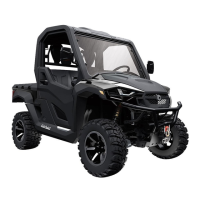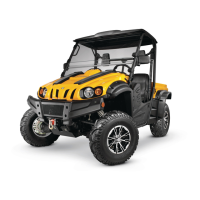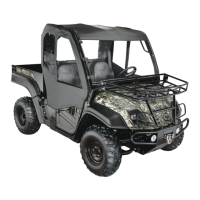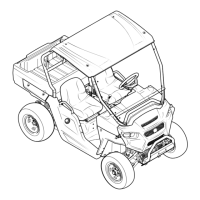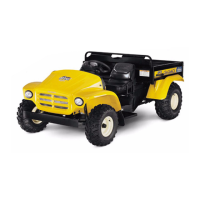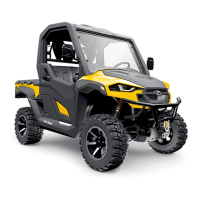10 Section 3 — controlS & operation
Operation
First 50 Hours
How a new vehicle is handled and maintained
determines the life of vehicle.
A new vehicle just off the factory production line
has been, of course, tested, but various parts are
not fully aligned, so the operator should pay more
attention to operating the vehicle for the first
50 hours at a slower speed and avoid excessive
work or operation until the various parts become
“broken-in.” The manner to which you handle the
vehicle during “breaking-in” period greatly affects
the life of your vehicle. Therefore, to obtain the
maximum performance and the longest life of the
vehicle, it is very important to properly break-in
your vehicle. For better handling a new vehicle, the
following precautions should be observed.
• Do not operate the vehicle at full speed for
the first 50 hours.
• Do not start quickly nor apply the brakes
suddenly.
• In winter, operate the vehicle after fully
warming up the engine.
• Do not run the engine at speeds faster than
prescribed.
• On rough roads, slow down to suitable
speeds.
• Do not operate the vehicle at fast speed.
The above precautions are not limited to new
vehicles. However, they should be especially
observed for new vehicles.
Note: The lubricating oil is especially important
for a new vehicle. Various parts need time to wear
and polish themselves to the correct operating
clearances. Small pieces of metal grit may develop
during the operation of the vehicle; and this
may wear out or damage the parts. Therefore,
change the lubricating oil a little earlier than
would ordinarily be required. For further details
of change interval hours, see the Product Care
section of this manual.
Starting the Utility Vehicle
WARNING
Seat belts reduce injury. Always wear your seat belts. The
lap-style seat belts may not provide adequate protection
for small children. Pay special attention when carrying a
child passenger. Always use the seat belts when operating
and riding in the vehicle.
General Safety
• RECEIVE INSTRUCTION — Entirely read
this operator’s manual. Learn to operate
this vehicle SAFELY. Do not risk INJURY or
DEATH. Allow only those who have become
competent in its usage to operate this utility
vehicle.
• Before starting the engine or beginning
operation, be familiar with the controls.
• Read the danger, warning and caution labels
located on the vehicle.
• To avoid the danger of exhaust fumes, do
not operate the utility vehicle in closed
buildings without proper ventilation.
• Start engine only from operator’s seat.
Never start the engine while standing
outside the utility vehicle.
• Make sure the shift lever is in the NEUTRAL (N)
or PARK (P) position before starting the engine.
Starting the Engine
Note: Do not use starting fluid or ether.
Note: To protect the battery and the starter, make
sure that the starter is not continuously turned for
more than 5 seconds.
1. Engage the parking brake.
Note: The parking brake lamp is illuminated
when the parking brake is applied and turns
off when it is released. See Figure 3-2.
2. Place the shift lever in the NEUTRAL (N) or
PARK (P) position.
Note: The engine will not start without the
gear shift in the NEUTRAL (N) or PARK (P)
position and the brake depressed.
3. Insert the key into the ignition and turn it to
START position. Release the key when the
engine starts. See Figure 3-3.
Figure 3-3
Note: The ignition is a 4-position switch,
the positions and brief description of each
is below:
a. OFF — Engine is off and the key can
be removed.
b. ACC — Accessories such as radio are
on, but engine is off.
c. ON — Engine and all accessories
are on.
d. START — Starter motor on, the key
will return to the ON position when
released.
Note: When the ambient temperature is
below -15°C (5°F), the engine is very cold. If
the engine fails to start after 5 seconds, turn
off the key for 30 seconds and start again.
Stopping the Engine
1. After slowing the engine to idle, turn the key
to the OFF position.
2. Remove the key.
Warming Up
CAUTION
Be sure to set the parking brake during warm-up. Be sure to
set the shift lever to the PARK position during warm-up.
For 5 minutes after engine start-up, allow the engine
and transmission to warm up without applying any
load. This is to allow oil to reach every engine part. If
load applied to the engine or transmission without
warming up, damage may occur.
Driving the Utility Vehicle
1. Adjust the seat belt to fit comfortably
around your lap, then buckle the seat belt.
WARNING
Do not operate the vehicle without the OPS in place and the
seat belt fastened securely around your waist and chest.
2. Start the engine as instructed in the Starting
the Engine section and make sure the front
wheels are turned to the desired direction
of travel.
CAUTION
Immediately stop the engine if the engine suddenly slows
down or accelerates, unusual noises are suddenly heard or
exhaust fumes suddenly become very strong.
3. Push down on brake pedal and pull slightly
back on the parking brake lever while
depressing the lock button and then slowly
push forward to release the parking brake.
4. Push down on brake pedal and move the
shift lever into the desired setting. To avoid
damaging the transmission, depress the
brake pedal fully and make sure the vehicle
is completely stopped before shifting into
high (H), low (L) or reverse (R).
WARNING
Do not stop or start suddenly when going uphill or downhill.
Be cautious when changing direction on slopes. Apply brakes
when going down slopes to maintain control of vehicle.
5. Release brake pedal and slowly apply
pressure to the gas pedal.
6. Release gas and apply brake pedal evenly
and firmly to slow down or stop.
2WD/4WD
CAUTION
When traveling at road speed, use only 2WD. When driving on
icy, wet or loose surfaces, make sure the vehicle is correctly
loaded to avoid skidding and loss of steering control. Reduce
the speed and engage front wheel drive. Accident may occur
if the vehicle is suddenly braked, such as heavy towed loads
shifting forward causing loss of control. The braking
characteristics are different between two and four wheel
drive. Be aware of the differences and operate carefully.
To activate the 4WD stop the utility vehicle and
press down on the lower half of the 2WD/4WD
switch. To return to 2WD, stop the utility vehicle
and press down on the upper half of the 2WD/4WD
switch. When in 2WD just the two rear tires will be
filled on the instrument cluster indicator, when in
4WD all four tires will be filled. See Figure 3-4.
2WD 4WD
Figure 3-4

